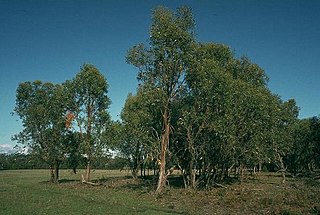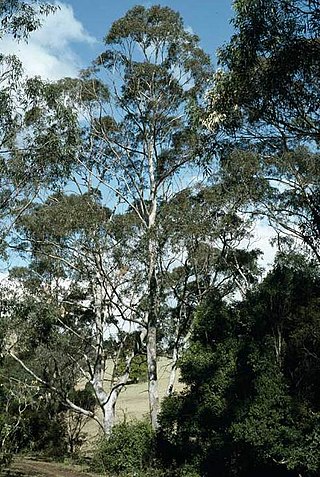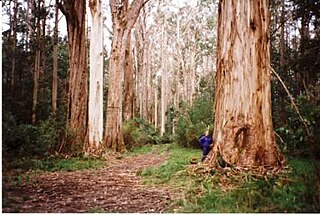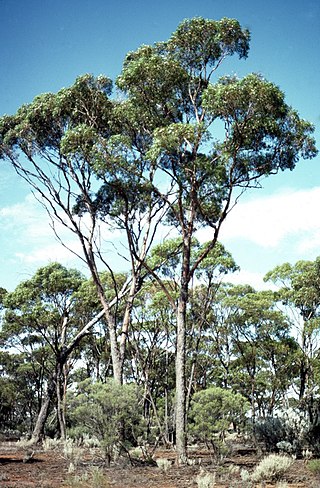
Eucalyptus morrisbyi, commonly known as Morrisby's gum, is a species of small to medium-sized tree that is endemic to a restricted area of Tasmania. It has loose slabs of rough bark near the base of its trunk, smooth pale grey bark above, lance-shaped to egg-shaped adult leaves, flower buds in groups of three, white flowers and barrel-shaped or cylindrical fruit. It is only known in the wild from a few small populations but has been widely planted as an ornamental.

Eucalyptus saligna, commonly known as the Sydney blue gum or blue gum, is a species of medium-sized to tall tree that is endemic to eastern Australia. It has rough, flaky bark near the base of the trunk, smooth bark above, lance-shaped to curved adult leaves, flower buds in groups of seven, nine or eleven, white flowers and cylindrical to conical or cup-shaped fruit.

Eucalyptus pulverulenta, commonly known as silver-leaved mountain gum, is a species of straggly tree or mallee that is endemic to southern New South Wales. It has smooth bark, egg-shaped, heart-shaped or round, sessile leaves arranged in opposite pairs, flower buds in groups of three, white flowers and cup-shaped to cylindrical fruit.

Eucalyptus rubida, commonly known as candlebark, ribbon gum or white gum, is a species of small to medium-sized tree that is endemic to south-eastern Australia. It has smooth bark, sometimes with rough bark at the base, lance-shaped or curved adult leaves, flower buds in groups of three, white flowers and cup-shaped, hemispherical or bell-shaped fruit.

Eucalyptus globulus subsp. bicostata, commonly known as the southern blue gum, eurabbie, blue gum or Victorian blue gum, is a subspecies of tree that is endemic to south-eastern Australia. It has mostly smooth bark with some persistent slabs of old bark at the base, juvenile leaves with one glaucous side, glossy, lance-shaped adult leaves, warty flower buds in groups of three, white flowers and hemispherical to conical fruit.

Eucalyptus nitens, commonly known as shining gum or silvertop, is a species of tall tree native to Victoria and eastern New South Wales. It has smooth greyish bark, sometimes with thin, rough bark near the base, lance-shaped adult leaves, flower buds in groups of seven or nine, white flowers and cup-shaped, barrel-shaped or cylindrical fruit. It grows in wet forests and rainforest margins on fertile soils in cool, high-rainfall areas.

Eucalyptus vernicosa, commonly known as varnished gum, is a species of shrub or a mallee that is endemic to mountainous areas of Tasmania. It has smooth greyish bark, crowded, egg-shaped to elliptical or round leaves, flower buds singly or in groups of three in leaf axils, white flowers and hemispherical or bell-shaped fruit.

Eucalyptus kitsoniana, commonly known as the Gippsland mallee or bog gum, is a species of small tree or mallee and is endemic to Victoria. It has mostly smooth bark, a crown containing juvenile, intermediate and adult leaves, flower buds in groups of seven, white flowers and sessile, cup-shaped to hemispherical fruit.

Eucalyptus imlayensis, commonly known as the Mount Imlay mallee, is a species of small, straggly mallee that is endemic to the far south east of New South Wales, only occurring near the summit of Mount Imlay. It has mostly smooth bark, lance-shaped to curved adult leaves, flower buds in groups of three, white flowers and cup-shaped, bell-shaped or hemispherical fruit.

Eucalyptus quadrangulata, commonly known as the white-topped box or coast white box, is a species of small to medium-sized tree that is endemic to eastern Australia. It has rough, fibrous or flaky bark on the trunk and branches, lance-shaped to curved adult leaves, flower buds in groups of seven, white flowers and conical fruit.

Corymbia henryi, commonly known as the large-leaved spotted gum, is a species of small to medium-sized tree that is endemic to north-eastern Australia. It has smooth, mottled bark, lance-shaped adult leaves, flower buds in groups of three, white or lemon yellow flowers and barrel-shaped to urn-shaped fruit.

Eucalyptus benthamii, commonly known as Camden white gum, Bentham's gum, Nepean River gum, kayer-ro or durrum-by-ang, is a species of tree that is endemic to New South Wales. It has mostly smooth bluish grey or white bark, lance-shaped to curved adult leaves, flower buds arranged in groups of seven, white flowers and cup-shaped, bell-shaped or conical fruit.

Eucalyptus denticulata, commonly known as the Errinundra shining gum or shining gum, is a species of tree endemic to south-eastern Australia. It has mostly smooth, white bark, lance-shaped to curved adult leaves with toothed edges, flower buds in groups of seven, white flowers and cup-shaped, barrel-shaped or cylindrical fruits. It is similar to E. nitens and was previously included in that species.

Eucalyptus johnstonii, commonly known as Tasmanian yellow gum, is a species of medium-sized to tall tree endemic to Tasmania. It has smooth yellow to greenish bark, lance-shaped adult leaves, flower buds in groups of three, white flowers and hemispherical or bell-shaped fruit.
Eucalyptus quinniorum, commonly known as monkey gum, is a species of mallee or a small to medium-sized tree that is endemic to northern New South Wales. It has smooth bark with persistent, stringy bark near the base, linear to narrow lance-shaped adult leaves, flower buds in groups of seven, white flowers and hemispherical to cylindrical fruit.

Eucalyptus longicornis, commonly known as red morrel, morryl, poot or pu, is a species of large tree that is endemic to the south-west of Western Australia. It has rough, fibrous, fissured bark on the trunk, smooth greyish bark above, flower buds in groups of seven or more, white flowers and shortened spherical fruit.

Eucalyptus stricklandii, commonly known as Strickland's gum, is a species of small tree that is endemic to Western Australia, but possibly also naturalised in Victoria. It has rough, crumbly to flaky bark near the base of the trunk, smooth reddish brown to grey bark above, lance-shaped adult leaves, flower buds in groups of seven, yellow flowers and bell-shaped fruit.

Eucalyptus uncinata, commonly known as the hook-leaved mallee, is a species of mallee that is endemic to the southwest of Western Australia. It has smooth bark, lance-shaped adult leaves, flower buds arranged in groups of nine to thirteen, creamy white flowers and barrel-shaped to oval or cylindrical fruit.

Eucalyptus urnigera, commonly known as urn tree, is a species of small to medium-sized tree that is endemic to Tasmania. It has smooth bark, lance-shaped or elliptical leaves, flower buds in groups of three, white flowers and urn-shaped fruit.

Eucalyptus globulus subsp. globulus, commonly known as the Tasmanian blue gum, southern blue gum, or blue gum, is a subspecies of tree that is endemic to southeastern Australia. It has mostly smooth bark with some persistent slabs of old bark at the base, juvenile leaves with one glaucous side, glossy, lance-shaped adult leaves, warty flower buds arranged singly in leaf axils, white flowers and hemispherical to conical fruit that is more or less square in cross-section.






















